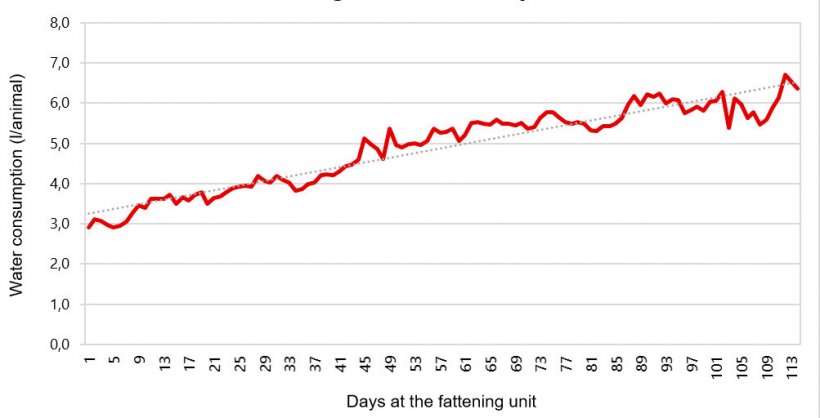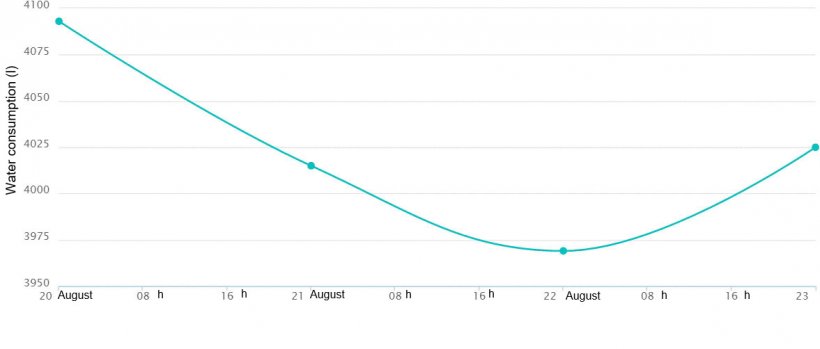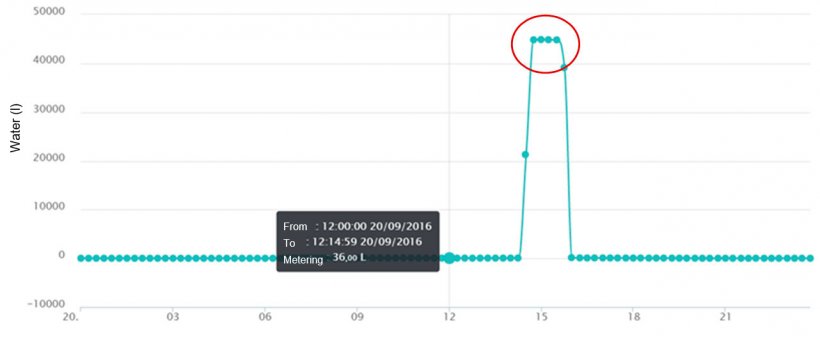Water is a fundamental requirement with an essential role in metabolic functions and acid-basis homeostasis, physiological functions such as maintaining body temperature, milk composition and also nutrients and hormones transport. At the same time, water guarantees the metabolic excretion.
Considering all these issues, knowing the quantity and quality of water and making sure we achieve some specific goals, it is important, not just to control animal production, but also to maximize performance.

During fattening, increasing body weight is related with increasing water consumption. Several data can be found, and the factors having an influence must be considered. Figure graphic 1 represents an example.

Considering water consumption is under greater control by the pig than feed – that is more human dependent – it may be a very relevant indicator. There are several factors that can contribute to variations in water intake. So, it can be mentioned body weight, temperature, diet composition or feeding level. Nevertheless, monitoring water quality is also important since this factor may influence water intake. Furthermore, some authors and practitioners already point water consumption as a health/disease, welfare or production problems indicator.
Although, it has been observed that outbreaks of diseases, changes in feed quality or ventilation problems can change the drinking behaviour, it is relevant to understand that in some situations the changes are not related with quantity, but just with frequency and duration of drinking (Matthews et al., 2016).
Based on producer and veterinarian observations, daily water usage reductions for three days, or drops higher than 30% from day to day may reflect a potential health challenge. Since 1994, there were already thoughts that it might be possible to use decreased water intakes as an indicator of impending respiratory disease. Also, there have been observations that pens that showed a strong tendency towards reduced water consumption, scored for occurrence of scour some days after this reduction. Furthermore, Ahmed (2015) referred that Salmonella infection in pigs resulted in reduced feeding and drinking activity. Those type of observations show the potential of water recording as a monitoring tool for subclinical disease detection. Last, but no least, water consumption reduction can be related to feeders’ blockage and the derived production problems and increased risk of tail biting.
As a practical example of water consumption as a monitoring of subclinical disease Figure 2 represents total water consumption in a fattening unit during four days, and the variations of water consumption associated with disease. The group represented had 600 animals with 87 days at the fattening unit. Those pigs came from a farm with a diagnosed history of Swine Dysentery (SD) caused by Brachyspira hyodisenteriae. Clinical signs of SD started to appear in one pen (day 1), spreading to two more pens in day 2 and two more at day 3. During these days and after the detection, the animals on the affected pens were treated with lincomicin (via IM). However, considering, the general decrease of water consumption, the clinical signs of the disease and the continuous detection of new pens with problems, it was decided to use zinc chelate via drinking water. The increase of water consumption at the fourth day corresponds with the beginning of the treatment. Although more data are necessary, the staff of this farm learnt how to use water consumption to detect the problem as soon as possible. Actually, the water consumption data helped their farm management and led to better results.

Water consumption can be different from water measurement due to wastage. In this way, is important to know the thresholds and being alerted when the values are lower or higher. A problem in the water deposit – that can be also monitored – or in the water pump can lead to a lower water passage and, consequently, low water intake. There are some consequences of low water intake like reduced feed intake and average daily gain, dehydration, salt poisoning and, in extreme cases, death.
On the other hand, and as can be seen on figure 3, during night time it is expected to have periods without water consumption. Should this not be occurring, it may be an indicator of water losses and wastage.

Furthermore, a problem related to nipple or water pipe issues, can lead to big amounts of wasted water. A practical example of an extreme situation is shown in figure 4. Water consumption during the day was not zero – for example between 12:00:00 and 12:14:59 the animals consume 36 l of water. However, during one hour, the water consumption is 44 850 l per 15 minutes.

The importance of water shows that understanding its consumption and knowing the factors that may affect it, are important points in animal production and health. Early treatments are always more effective, and as the new regulations limit some of those treatments, early detection will be even more important.
Nevertheless, it is relevant to continue working so that we can act more in a preventive way, considering animal health and performance.




